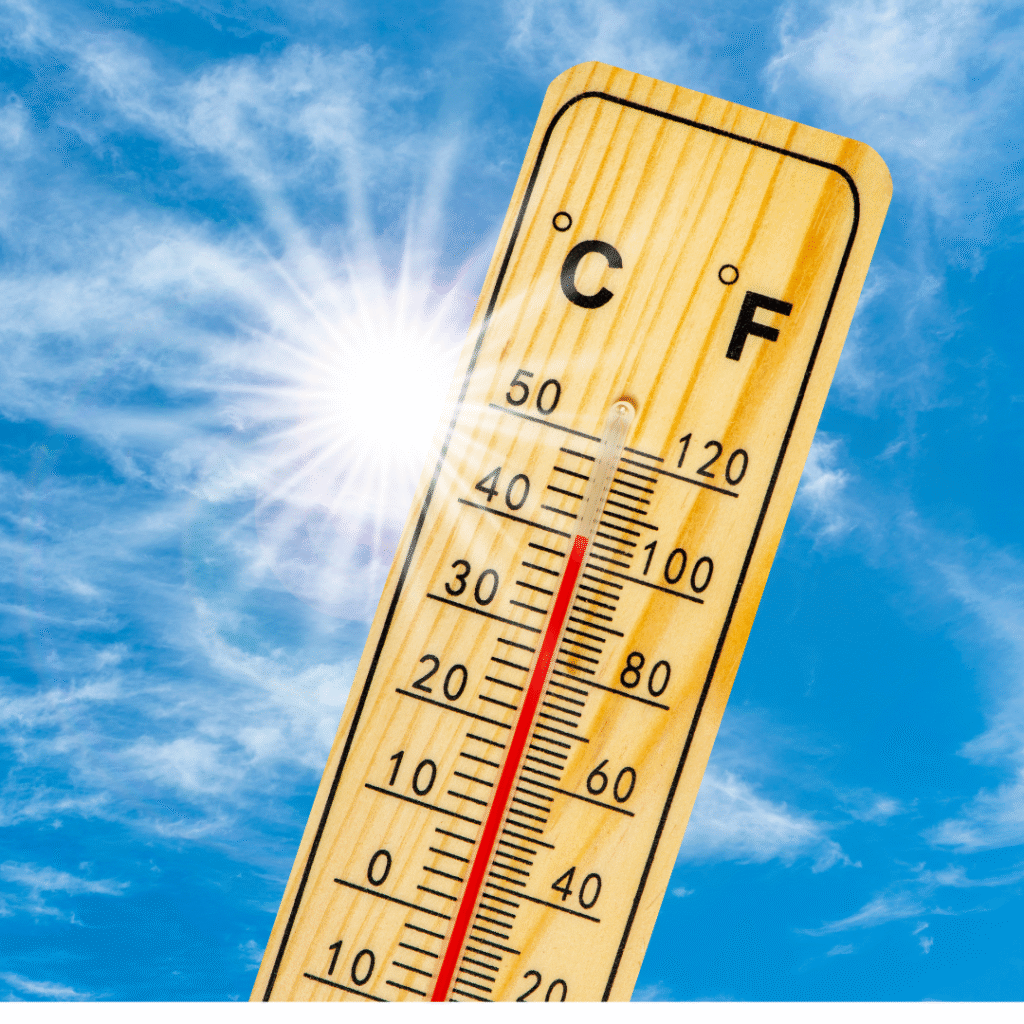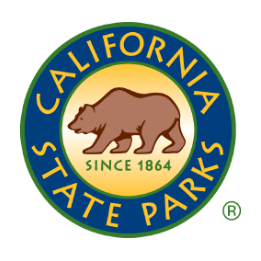Summer in Anza-Borrego Desert State Park is not just hot, it’s extreme. From June through September, daytime highs often soar past 100°F, with rock and sand surfaces reaching 140–150°F—hot enough to fry an egg in minutes. Even as the sun sets, temperatures linger near 80°F+, offering little relief after dark. In this environment, careful planning and respect for the desert’s power are essential. Below, you’ll find everything you need to know, from monitoring surface and air temperatures to recognizing the signs of heat illness, packing enough water, and understanding seasonal trail and campground closures so you can experience Anza-Borrego’s rugged beauty safely and responsibly.
Air Temperatures: From June through September, daily highs frequently exceed 100°F, and on the hottest days, can top 115°F. Even inside a tent or shelter, trapped heat can push the temperature higher than the ambient air.
Surface Temperatures: Direct sunlight on rocks, asphalt, and sand can heat surfaces to 140–150°F. At these temperatures, exposed skin can burn in just seconds, and you can literally fry an egg on a sidewalk. (Eggs begin to cook once the surface temperature surpasses about 130°F)
Nighttime Heat: While deserts cool off after sunset, summer nights often linger around 80°F, or even higher! If you plan an overnight trip, pack lightweight, breathable sleepwear and vents for your tent. Staying cool matters even when the sun goes down.
Top 10 Tips for Staying Safe in Extreme Heat
- Research the Weather First: Before venturing out, check hourly forecasts on a reliable weather app or website. Note not only highs and lows but also predicted wind, humidity, and any heat advisories.
- Avoid Peak Heat Times: Plan your outdoor activities for the early morning (sunrise to 10 a.m.) or late afternoon (after 4 p.m.). From roughly 10 a.m. to 4 p.m., direct sun can quickly overwhelm your body’s cooling mechanisms.
- Bring (and Drink) Plenty of Water: For hikes, carry at least one gallon (3.8 liters) of water per person per day—and then pack more “just in case.” Dehydration sets in fast; if you run out, you could be stranded for hours in lethal conditions.
- Tell Someone Your Plans: Always share your itinerary—where you’re going, what time you expect to return, and who to contact if you’re late. In a park this vast, cell service can become spotty, so having someone aware of your schedule is crucial.
- Learn to Recognize Heat Illnesses: Heat Exhaustion: Symptoms include heavy sweating, weakness, headache, dizziness, nausea, and muscle cramps.
Heat Stroke: Characterized by high body temperature (above 104°F/40°C), confusion, rapid pulse, and hot, dry skin. If you or your companion experiences any of these symptoms, seek shade immediately, sip water, and use damp cloths to cool down. Call for help if symptoms worsen. - Dress for the Desert: Choose lightweight, loose-fitting, breathable, and light-colored clothing—bonus points for fabrics with built-in SPF (50+). A wide-brimmed hat and UV-blocking sunglasses protect your face and eyes from the sun’s harmful rays. Avoid dark colors that absorb heat.
- Skip Dehydrating Beverages: Alcohol, coffee, and standard tea can dehydrate you faster. Instead, sip electrolyte-enhanced drinks (sports beverages, electrolyte powders) if you’re sweating heavily or staying out longer than planned.
- Apply Sun Protection: Apply broad-spectrum, water-resistant sunscreen (SPF 30 or higher) to all exposed skin. Reapply every two hours or more often if you’re sweating. A high-SPF lip balm and a neck gaiter (worn loosely) can block reflected heat.
- Seek Shade Frequently & Rest:
Whenever possible, take breaks under natural shade (rock overhangs, palo verde trees) or set up a pop-up canopy. Taking a little rest every 30–60 minutes helps your body recover and avoid overheating. - Have a Backup Plan: Sometimes, the desert becomes too hot, even at early or late hours of the day. Always identify a cool, indoor option (visitor center, local café, or hotel room with air conditioning) if conditions turn dangerous.
Summer Closures & Services (June 1–September 30)
Make sure you know what areas of the Park remain open during the summer. The annual seasonal closures below will be effective June 1 – September 30.
- Coyote Canyon from Anza to 3rd crossing or vice versa. Coyote Canyon is open to the public from Coyote Canyon Entrance (Di Giorgio Rd) to 3rd crossing. Vehicular traffic past the 3rd crossing is closed indefinitely.
- Vern Whitaker Horse Camp
- Tamarisk Grove Campground
- Borrego Palm Canyon Tent sites 54-89, 90-99, 111-116
- Borrego Palm Canyon Group Sites G 1-5 & Hike & Bike
The Visitor Center will be open on holidays and weekends only from 9:00 a.m. – 5:00 p.m. through September 30.
Planning a hike in the Park?
All trails are currently open to the public during the summer season, but it is recommended that all park visitors are off the trails and in air conditioning by 10 a.m. due to the desert’s extreme summer temperatures and heat conditions. Hiking in the desert is not recommended during the heat of the day. Park visitors should carry a minimum of one gallon of water per person, protective clothing, sunscreen, food, shade devices, and a fully charged cell phone or alternate method to communicate when hiking. Never hike alone and tell someone what your hiking plans are in case of an emergency.
Why These Precautions Matter
- Rapid Onset of Danger: In desert heat, body temperature can spike within 15–20 minutes of strenuous activity. Even short side hikes can turn perilous if you misjudge the actual temperature on the ground.
- Illness Accumulates: Heat exhaustion can escalate into heat stroke in under 30 minutes if left untreated.
- Unforgiving Environment: The combination of a lack of shade, extreme dryness, and intense sunlight saps your strength faster than most people expect. Even seasoned hikers can become disoriented when their core temperature rises unchecked.
Plan a Cooler Experience
- Sunrise Photography or Stargazing: The desert’s dry air yields incredible clarity at dawn and dusk. If you’re a photographer, plan to shoot before 9:00 a.m. or after 6:00 p.m. Stargazers should arrive well before dusk to let their eyes adjust, as temperatures often reach the 80s°F once the sun dips below the horizon.
- Short, Shaded Walks: Rather than tackling long, exposed desert washes, choose trails through palm groves or near riparian areas. These pockets often retain micro-shade and slightly cooler air, especially in the early morning.
- Evening Drives & Scenic Overlooks: If hiking isn’t essential, consider driving the S22 (Montezuma Grade) to Highway 78 around sunset for a scenic overlook. Watch the mountains glow orange, then transition to prismatic reds as twilight falls. This way, you experience the desert’s beauty without the risk of the midday heat.
Anza-Borrego’s heat is a powerful reminder that the desert is an extreme environment. Treat its summer temperatures with the same respect you would a roaring river or snowy mountain pass.
By checking the forecast hourly, timing your adventures for cooler windows, packing—then carrying—extra water, knowing when to retreat indoors or to shaded sites, you’ll dramatically reduce your risk of heat-related illness. And by understanding that a seemingly “short” trail can quickly become a life-threatening ordeal once temperatures exceed 100°F, you’ll make safer, more informed choices that let you appreciate Anza-Borrego’s grandeur—without becoming another cautionary statistic.
Stay cool, stay hydrated, and stay safe!





